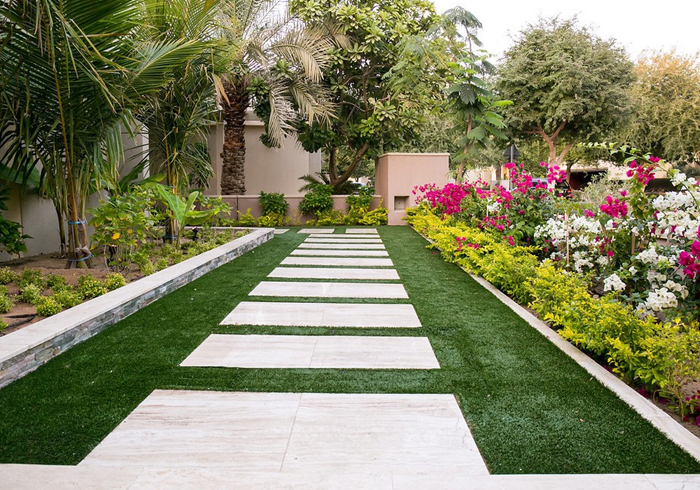Landscape Design Fundamentals Explained
3 Simple Techniques For Landscape Design
Table of ContentsThe Single Strategy To Use For Landscape DesignNot known Factual Statements About Landscape Design Top Guidelines Of Landscape DesignLandscape Design Fundamentals Explained
Formal style theme. Credit Report: Gail Hansen, UF/IFAS The lawn is an extension of the home where a range of tasks occur. A yard can typically be separated right into 3 areas: public (the front yard), personal (the garden), and solution (normally the side backyard). The area of activity locations depends mostly on the sort of location, the size of area required, the type of activity, and the preferred closeness to various other tasks and frameworks (Landscape Design).
The outside wall of your home commonly works as the initial wall surface or starting point of an outside area. Inappropriate uses need to be divided, and related tasks, such as food preparation and eating, ought to be created to make the yard more efficient and satisfying. When making use of hardscape to create areas, utilize construction product comparable to that utilized in the house for connection from your home right into the yard.
Connected rooms. Credit History: Gail Hansen, UF/IFAS Utilizing similar hardscape attributes and repeating plants draws the eye around the yard. Essential points in the process can be stressed with growings or attributes that draw focus and encourage movement in a particular instructions. Relocating along the path takes a person from one area to the following and allows the customer to have a selection of experiences.
From a style point of view, plant materials have three significant features in the landscape: visual, structural and practical. Visually, plants create an aesthetically pleasant atmosphere and structurally plants arrange and define rooms.
A Biased View of Landscape Design
For psychological convenience plants are utilized as physical or suggested barriers for personal privacy and safety. Physical obstacles obstruct both the view and accessibility to a space and include fences, wall surfaces and plant hedges.
Physical and suggested obstacles. Debt: Gail Hansen, UF/IFAS For these reasons, the kinds of plants to be made use of (such as trees, hedges, or groundcovers) must be picked in the onset of preparation. Plant types are selected for their useful abilities to ensure that their future function and required space can be taken into consideration at the very same time.
The above airplane, the vertical aircraft and the ground plane must all be taken into consideration to produce room. Once the shape of a plant bed has been established, the plants need to be massed (organized) and layered to accomplish aesthetic unity and the preferred quantity of unit. The dimension of a plant mass will depend upon the total size of the lawn, the size of the private plants in the mass, and the focus or influence wanted from the plant material.
Each plant mass is in front of, behind, or beside, an additional mass. Number 11. Horizontal plant layers. Credit Report: Gail Hansen, UF/IFAS Figure 12. Upright plant layers. Credit Scores: Gail Hansen, UF/IFAS Repeating plants within a mass and repeating masses with similar plants links the yard together. The individual plant features need to be considered to efficiently layer and mass plants.
What Does Landscape Design Do?
All plant compositions begin with the primary framework plants, the huge, mainly evergreen background plants-such as the trees and huge hedges. These plants different or enframe areas, manage the size of the space, and give the starting point for picking the appropriate features of the second layer, midground plants, for massing and infill.
Vital factors in the garden ought my sources to be highlighted by the use unique plants, unique frameworks, or garden accessories. Marking limits or entryways to areas can be finished with entrances, arbors, and actions, or via using one-of-a-kind and colorful plants. The kind and/or design motif of the garden will certainly typically assist establish the crucial factors and just how they need to be highlighted.
Various other vital places in the yard are focal points, which is utilized to aesthetically arrange a landscaped location. Different point of views or perspectives can reveal various make-ups in the landscape that may need a selection of focal points.
Landscape Design Fundamentals Explained
Plant types. Credit Scores: Gail Hansen, UF/IFAS After type, texture is the following leading function of a plant; coarse, tool and great textures can be made use of for contrast and emphasis in the landscape.


The enjoyable aroma of plants, the audio of wind in the trees, the audio and texture of water, and the colors and appearances of sculptures, pots and garden furnishings all contribute to the experience of the garden. One information that is frequently overlooked is the impact of light on the aesthetic appeals of the plants.
The whole click here for info garden modifications in function and appearance throughout the day, and the training course of a year, as the light and temperature adjustment from morning to evening and period to season. Plant choice have to think about a plant's development rate, its mature size and kind, and the upkeep it will certainly call for.
It is important to understand the eventual mature size of plants so they can be put in the right area and spaced properly when they are mounted. Providing plants space to grow is a difficulty because the common fully grown dimension is generally based upon optimum expanding problems More Help and the environmental problems of a site might cause a plant to expand bigger or stay smaller.